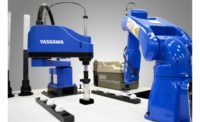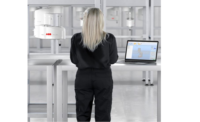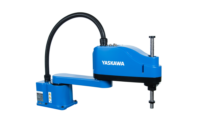As consumer spending habits continue to evolve and shift amid a global pandemic, manufacturers are reevaluating their production capacity and implementing new technologies to deal with the uptick in demand. From ultra-compact articulated robot usage to easy-to-use collaborative robots and more, there are multiple robot options being implemented into existing lines to gain the flexibility needed to address current production challenges — that include production increases and the need for employee social distancing.
For a variety of industries including plastics, electronics, food and beverage, clinical laboratory, appliance and medical device manufacturing, 4-axis SCARA (Selective Compliance Articulated Robot Arm) robots are an appealing option being chosen by manufacturers in today’s shifting market. With the ability to facilitate fast and precise operation for small part processing tasks and the growing need to accommodate mass production with minimal operational costs, SCARA robot usage is expected to nearly double by 2026, according to a report published by Allied Market Research.
Highly Precise and Fast Operation
Due to the simple structure SCARA robots offer, they are often faster and less expensive than six-axis robots, making them an ideal "middle ground" choice in terms of cost and speed between deltas and six-axis articulated arms. SCARA’s, such as Yaskawa SG-series robots, offer the highest operating performance in their class and are ideal for high-precision operation with a repeatability of ±0.01 mm.
Easily Integrated with Existing Automation
SCARA robots have a small footprint and easily integrate with existing robot applications and other machinery to expand current automated processes. Four-axis SCARA robots are ideal for a variety of applications, including pick-and-place, sortation, dispensing, inspection, assembly and insertion tasks. Compact design, which minimizes mounting space, and high work envelope to mounting surface ratio offer a simplified design compared to six-axis robot arms. Similarly, SCARA robots offer fast operation without the need for an overhead structure like delta robots, making them an attractive option for high-density factory layouts and quick deployments on demand.
Quick and Efficient Installation
A single cable is usually all that is needed to connect Yaskawa SCARA models to the robot controller. This results in easy setup, as well as reduced expenses for maintenance and spare parts inventory. Built-in air lines, user IO wiring and a hollow tool shaft also serve to simplify tool integration. A wide variety of fieldbus connectivity options are available.
Easy Vision Integration
SCARA robots can also be integrated with vision functionality, such as MotoSight 2D — a highly versatile, easy-to-use system that provides feature-rich functionality. This can reduce the cost of expensive tooling for locating parts and enable quick redeployment as parts change.
Compact Controller with Intuitive Programming
Floorspace availability is often a concern for manufacturers. For this reason, SCARA robots are controlled by compact, yet robust, controllers. Typically, these ultra-compact controllers can be installed in either a vertical or horizontal position, as well as within a 19-inch rack, optimizing valuable floor space.
Yaskawa’s optional MLX300 software package enables Yaskawa SCARA robots to be programmed and controlled using widely accepted Add-On Instructions (AOI’s) in the same fashion as many Programmable Logic Controllers (PLCs.) This allows seamless integration into existing automation and requires minimal operator training by leveraging the existing knowledge and experience of PLC programmers.
Consistent Operation for Unpredictable Situations
As seen in recent months with the global pandemic, humans working in close proximity can easily spread illness. Adding automation to current operations not only reduces the risk of spreading germs from person to person, but it can also limit the exposure of illness to products and packaging.
Highly flexible, precise and compact SCARA robots can help manufacturers attain production results, while requiring minimal capital investment, creating momentum for an array of tasks across multiple industries, boosting production and accelerating return on investment in a fluctuating market.









